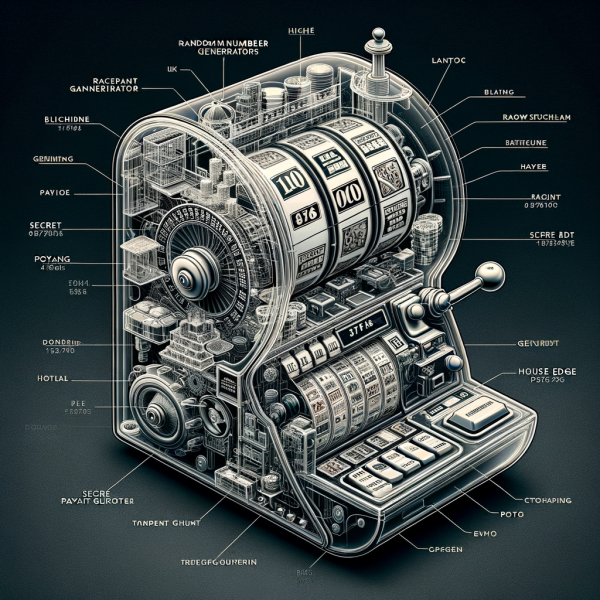Slot machines are one of the most popular gambling devices in casinos around the world. Their allure lies not only in the chance of winning big but also in the intricate mechanics that govern their operation. Understanding what goes on inside a slot machine can deepen appreciation for the game and inform better play strategies. This article will dissect the components of slot machines, explaining their workings and what players need to know.
Understanding the Fundamentals of Slot Machine Mechanics
At the core of every slot machine is a system designed to create random outcomes based on player input. Traditional slot machines operated with physical reels and mechanical parts, while modern machines are predominantly digital, employing advanced technology to deliver dynamic gaming experiences. The basic functionality remains the same: players insert money, pull a lever or press a button, and the reels spin before stopping to reveal symbols.
The inner workings of a machine include several key components: the reels, the symbols, the paylines, and the coin mechanism. In mechanical slots, these components were intricately linked through gears and motors, whereas electronic slots use software to simulate the spinning of reels. Understanding these mechanical fundamentals provides insight into how outcomes are determined and why players experience a sense of thrill and unpredictability.
Another critical aspect is the display interface that conveys information to players. This includes the current bet, potential winnings, and bonus features. Modern machines often incorporate audio-visual effects to create an engaging atmosphere, influencing players’ perceptions and excitement levels. Even the sound of coins cascading into a tray is designed to enhance the gaming experience by providing immediate feedback on wins.
Finally, the design and layout of slot machines are meticulously crafted to attract players. Eye-catching themes, vibrant colors, and storytelling elements are all part of a machine’s appeal. The overall mechanics of a slot machine, from functional to aesthetic, work in unison to create an immersive environment that encourages prolonged play.
The Role of Random Number Generators in Gameplay
Central to the operation of modern slot machines is the Random Number Generator (RNG). The RNG is a specialized computer program that continually generates random sequences of numbers, ensuring that each spin is completely independent of previous spins. This randomness is crucial in maintaining fairness and unpredictability in gameplay, as outcomes cannot be influenced by external factors.
Each spin’s outcome is determined by the RNG at the precise moment the player activates the machine. Contrary to popular belief, players cannot predict future results based on past outcomes. The RNG operates continuously, generating numbers even when the machine is not in use, which means that results are entirely random and statistically independent.
The integrity of the RNG is paramount to the gaming industry. Independent testing laboratories often audit RNG systems to ensure compliance with regulations and fairness standards. These audits help maintain player trust and protect the interests of gaming operators. Players can be assured that the outcomes they experience are the product of a reliable and robust system designed to promote fairness.
Moreover, the introduction of RNG technology has paved the way for innovative features like progressive jackpots and bonus rounds. These features not only enhance gameplay but also increase the potential for significant wins, thereby attracting a wider range of players and enhancing the overall casino experience.
Analyzing the Symbol and Payline Configurations
In addition to the mechanical and digital components, the symbols and paylines on a slot machine play a crucial role in determining the game’s mechanics. Each slot machine has its unique set of symbols, which typically include high-value and low-value icons, as well as special symbols like wilds and scatters. Understanding these symbols is vital for players aiming to maximize their potential payouts.
The payline configuration is another critical element that influences gameplay. Traditionally, slots had a single payline running horizontally across the center of the reels. However, modern machines often feature multiple paylines, sometimes numbering in the hundreds or even thousands. This increase in paylines allows players more opportunities to win but also requires a more strategic approach to betting.
For instance, players may choose to activate all available paylines or select a specific number to bet on. The choice of paylines often affects the player’s total bet amount, and understanding how to leverage this can lead to more favorable outcomes. Furthermore, some games introduce cascading reels, where winning combinations disappear and new symbols fall into place, offering additional chances to win on a single spin.
Players should also familiarize themselves with the game’s paytable, which outlines how much each symbol is worth and the payout structure for various combinations. Knowing the value of different symbols and how they interact with the paylines can inform better betting strategies and enhance the overall gaming experience.
| Symbol | Payout for 3 Symbols | Payout for 4 Symbols | Payout for 5 Symbols |
|---|---|---|---|
| A | $10 | $50 | $200 |
| K | $8 | $40 | $150 |
| Q | $6 | $30 | $120 |
| Wild | $15 | $75 | $300 |
| Scatter | Free Spins | 2x Total Bet | Jackpot |
The Importance of Return to Player (RTP) Percentages
One of the most critical factors to understand in the world of slot machines is the Return to Player (RTP) percentage. RTP represents the theoretical percentage of wagered money that a slot machine will pay back to players over an extended period. For instance, a slot machine with an RTP of 95% is expected to return $95 for every $100 wagered.
RTP plays a crucial role in determining a player’s long-term experience with a slot machine. The higher the RTP, the lower the house edge, which translates into better odds for the player. Understanding RTP can help players make informed decisions about which machines to choose, maximizing their potential for returns over time.
However, it’s essential to recognize that RTP is calculated over thousands or millions of spins. This means that short-term outcomes can deviate significantly from the expected returns. Players may experience streaks of losses or wins, leading to misconceptions about a machine’s fairness or performance. Knowledge of RTP helps players maintain realistic expectations and approach the game with a balanced mindset.
Additionally, some casinos may advertise their machines’ RTP percentages, allowing players to select games based on performance metrics. This transparency can foster a more informed gaming environment, encouraging responsible gambling practices while enhancing players’ overall enjoyment.
How House Edge Influences Slot Machine Profitability
The house edge is another important concept that players should understand. It represents the mathematical advantage that the casino has over players. For slot machines, the house edge is calculated based on the RTP percentage. If a game has an RTP of 95%, the house edge is 5%, meaning that, theoretically, the casino retains 5% of all wagers made.
Understanding the house edge is fundamental for discerning how profitable a slot machine can be for the casino over time. While players may experience wins, the house edge ensures that the casino remains profitable in the long run. This aspect of slot mechanics is crucial in evaluating different games and understanding which may present better odds for the player.
While the house edge is a critical metric, it’s worth noting that it does not guarantee that players will lose their money over time. Many factors contribute to individual experiences, including variance, personal betting strategies, and sheer luck. Players can still find enjoyment and occasional success even when playing games with a higher house edge.
Additionally, casinos continuously seek to optimize their game offerings by analyzing performance data for various machines. By adjusting settings and features, casinos can maintain profitability while still providing entertaining gaming experiences for players. This dynamic balance between player enjoyment and casino profitability underscores the complexity of slot machine mechanics.
The Impact of Technology on Modern Slot Machines
The evolution of technology has significantly transformed the landscape of slot machines. From the introduction of video slots to the integration of touchscreen interfaces, technology has enhanced player engagement and broadened the appeal of slot gaming. Today’s machines feature high-definition graphics and animations, immersive soundscapes, and interactive gameplay elements that capture players’ attention.
Moreover, advancements in software development have facilitated the integration of innovative features such as skill-based elements and gamification. These developments allow players to influence certain aspects of gameplay, creating a more involved and interactive experience. The shift towards incorporating player skill has opened new avenues for engagement, particularly among younger audiences seeking more than just chance-based gameplay.
Mobile technology has also revolutionized how players interact with slot machines. With the rise of online casinos and mobile gaming, players can now enjoy their favorite games from anywhere. This accessibility has expanded the market for slot machines and introduced new ways for players to experience gaming. Many traditional casinos have adapted, offering mobile-compatible versions of their games to cater to this growing demographic.
Lastly, the use of big data and analytics in the gaming industry has allowed operators to better understand player behavior and preferences. This information can guide the development of new games and features, ensuring that machines remain competitive and appealing. The synergy between technology and slot machine mechanics is reshaping the future of gaming, creating opportunities for both players and operators alike.
Q&A Section
Q: How does a slot machine determine its outcomes?
A: Slot machines use a Random Number Generator (RNG) to determine outcomes. The RNG generates random numbers that correspond to symbols on the reels, ensuring each spin is independent and random.
Q: What is the difference between RTP and house edge?
A: RTP (Return to Player) is the percentage of wagered money that a machine pays back to players over time, while the house edge is the percentage that the casino retains. For example, a game with 95% RTP has a 5% house edge.
Q: Can I influence the outcome of a slot machine?
A: No, slot machine outcomes are determined by RNGs and are entirely random. Players cannot influence the results through strategies or previous outcomes.
Q: Are modern slot machines different from traditional ones?
A: Yes, modern slot machines are primarily digital and often feature advanced technology, including high-definition displays, interactive elements, and multiple paylines, unlike traditional mechanical machines.
Q: How can I choose the best slot machine to play?
A: Look for machines with higher RTP percentages, familiarize yourself with the paytable and features, and consider your budget and playing preferences when selecting a machine.






‘Cascading reels’ sounds fun! I want to try a game with that feature.
I didn’t realize how much design affects a slot machine’s appeal!
Wow, the technology in modern slots is amazing! I love the graphics.
Understanding paylines can help a lot. I’ll try to use this info next time!
‘Skill-based elements’ in slots? That’s new and exciting!
The RTP percentage is really important. I always check it before playing.
This article helps clarify what to look for when choosing a machine.
I never knew about the RNG! It’s interesting how it makes every spin random.
‘House edge’ explains why it’s hard to win. Good to know!